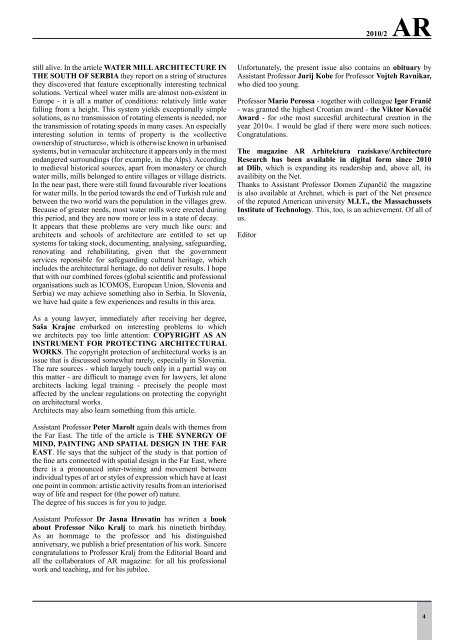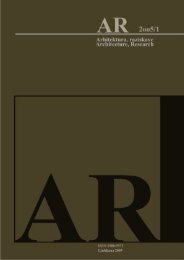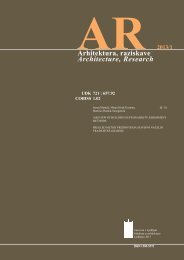AR 2010/2 - Fakulteta za arhitekturo
AR 2010/2 - Fakulteta za arhitekturo
AR 2010/2 - Fakulteta za arhitekturo
- No tags were found...
You also want an ePaper? Increase the reach of your titles
YUMPU automatically turns print PDFs into web optimized ePapers that Google loves.
<strong>2010</strong>/2 <strong>AR</strong>still alive. In the article WATER MILL <strong>AR</strong>CHITECTURE INTHE SOUTH OF SERBIA they report on a string of structuresthey discovered that feature exceptionally interesting technicalsolutions. Vertical wheel water mills are almost non-existent inEurope - it is all a matter of conditions: relatively little waterfalling from a height. This system yields exceptionally simplesolutions, as no transmission of rotating elements is needed, northe transmission of rotating speeds in many cases. An especiallyinteresting solution in terms of property is the »collectiveownership of structures«, which is otherwise known in urbanisedsystems, but in vernacular architecture it appears only in the mostendangered surroundings (for example, in the Alps). Accordingto medieval historical sources, apart from monastery or churchwater mills, mills belonged to entire villages or village districts.In the near past, there were still found favourable river locationsfor water mills. In the period towards the end of Turkish rule andbetween the two world wars the population in the villages grew.Because of greater needs, most water mills were erected duringthis period, and they are now more or less in a state of decay.It appears that these problems are very much like ours: andarchitects and schools of architecture are entitled to set upsystems for taking stock, documenting, analysing, safeguarding,renovating and rehabilitating, given that the governmentservices reponsible for safeguarding cultural heritage, whichincludes the architectural heritage, do not deliver results. I hopethat with our combined forces (global scientific and professionalorganisations such as ICOMOS, European Union, Slovenia andSerbia) we may achieve something also in Serbia. In Slovenia,we have had quite a few experiences and results in this area.Unfortunately, the present issue also contains an obituary byAssistant Professor Jurij Kobe for Professor Vojteh Ravnikar,who died too young.Professor Mario Perossa - together with colleague Igor Franič- was granted the highest Croatian award - the Viktor KovačićAward - for »the most succesful architectural creation in theyear <strong>2010</strong>«. I would be glad if there were more such notices.Congratulations.The magazine <strong>AR</strong> Arhitektura raziskave/ArchitectureResearch has been available in digital form since <strong>2010</strong>at Dlib, which is expanding its readership and, above all, itsavailibity on the Net.Thanks to Assistant Professor Domen Zupančič the magazineis also available at Archnet, which is part of the Net presenceof the reputed American university M.I.T., the MassachussetsInstitute of Technology. This, too, is an achievement. Of all ofus.EditorAs a young lawyer, immediately after receiving her degree,Saša Krajnc embarked on interesting problems to whichwe architects pay too little attention: COPYRIGHT AS ANINSTRUMENT FOR PROTECTING <strong>AR</strong>CHITECTURALWORKS. The copyright protection of architectural works is anissue that is discussed somewhat rarely, especially in Slovenia.The rare sources - which largely touch only in a partial way onthis matter - are difficult to manage even for lawyers, let alonearchitects lacking legal training - precisely the people mostaffected by the unclear regulations on protecting the copyrighton architectural works.Architects may also learn something from this article.Assistant Professor Peter Marolt again deals with themes fromthe Far East. The title of the article is THE SYNERGY OFMIND, PAINTING AND SPATIAL DESIGN IN THE F<strong>AR</strong>EAST. He says that the subject of the study is that portion ofthe fine arts connected with spatial design in the Far East, wherethere is a pronounced inter-twining and movement betweenindividual types of art or styles of expression which have at leastone point in common: artistic activity results from an interiorisedway of life and respect for (the power of) nature.The degree of his succes is for you to judge.Assistant Professor Dr Jasna Hrovatin has written a bookabout Professor Niko Kralj to mark his ninetieth birthday.As an hommage to the professor and his distinguishedanniversary, we publish a brief presentation of his work. Sincerecongratulations to Professor Kralj from the Editorial Board andall the collaborators of <strong>AR</strong> magazine: for all his professionalwork and teaching, and for his jubilee.4

















